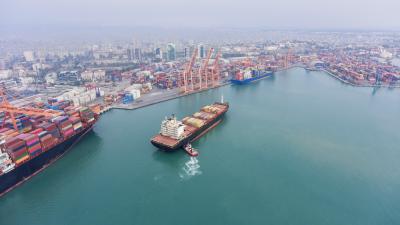Thomas is the Chairman of the Lloyd’s Register Foundation and Chairman of Lloyd’s Register Group Limited.
This page is approximately a 5 minute read
This page was published on

Thomas Thune Andersen, Chairman
Like all critical infrastructures, the 17,000 ports in the world are part of larger social, technical and physical systems that play an essential role in the movement of goods, people and services.
From bustling trade hubs handling containers, dry bulk and liquid cargo, to passenger terminals and fishing ports, these gateways are vital to the world’s economy.
With 80% of global trade moving through ports, they play an important role in international trade, economic growth and generating employment.
As global trade continues to evolve, the ports of tomorrow have a delicate balance to strike between advancing economic goals and safeguarding the planet’s future.
Through collaboration with companies across the sector, suppliers, customers, other industries, regulators, civil society and local communities, the port sector can champion a transformative shift that aligns with global biodiversity goals, securing a sustainable future for business and the planet.
We know that ports are under immense pressure from the impact of climate change. Higher temperatures, rising sea levels and more frequent and severe weather patterns will increasingly expose vulnerabilities in our infrastructure systems.
Due to their proximity to land and ocean, ports – particularly in small island developing states and the Global South – are uniquely impacted by these changes.
The Intergovernmental Panel on Climate Change estimates that if we continue current projected trends, sea levels are expected to rise to between 29 and 51 centimetres (cm) by 2100.
Under one scenario developed in Global Maritime Trends 2050, a report authored by Economist Impact and commissioned by Lloyd’s Register and Lloyd’s Register Foundation, it estimates that without major mitigating intervention, a 40 cm rise in sea levels could render the ports of Houston, Shanghai and Lazaro Cardenas completely unusable.
To meet these emerging challenges, transforming current approaches to port management and operations is key to creating a culture that actively protects, restores and enhances natural ecosystems at scale.
Overcoming these challenges will require significant investments in landside infrastructure, such as energy systems, industrial hubs and port refuelling facilities.
These systems will supply the fuels of the future for shipping while seamlessly integrating with other sectors. Such investments present a unique opportunity to drive the broader energy transition and generate significant social and environmental benefits.
This shift towards greener ports will play an essential role in achieving global climate goals, including the Paris Agreement’s call to reduce carbon emissions.
As the demand for port infrastructure continues to rise, there is an opportunity to create ports that are not only economically and socially beneficial but also “nature positive.”
By incorporating green design principles, restoring damaged ecosystems and investing in nature-based solutions, ports can act as stewards of economic and environmental health. Ports can then become a key player in the broader effort to protect and restore nature, contributing to the resilience of the local environment and the global supply chain.
Some leading ports are already taking action to mitigate their environmental impact. For example, the Port of Darwin in Australia has issued several environmental protection plans, including an environmental management plan and minimum environmental expectations, to minimize the impact of arriving ships on the local ecosystems.
The Mormugao Port in India is providing a discount on the port dues component of the vessel-related charges for the eco-friendly vessels calling at the Mormugao Port, based on the Environmental Ship Index score given by the International Association for Ports and Harbours.
As highlighted in the World Economic Forum’s Nature Positive: Role of Ports report, as existing ports are developed and new ports are constructed, there is an opportunity to take a more systematic approach to planning and managing their environmental impacts.
By considering the wider environmental consequences, including the loss of nature, ports can balance economic development and ecological preservation.
Ports are not just economic drivers; they are also integral to the social fabric of the communities they serve and the heartbeat of local economies, offering jobs, supporting local industries and driving growth.
The development of resilient, and integrated port systems requires that environmentally forward concepts and practices be incorporated into the operations and management of ports. Training port staff in sustainability practices, environmental protection and safety, is essential for promoting green initiatives within port environments.
A study by Credence Research suggests that the global port infrastructure market will grow from $164 billion in 2023 to $278 billion by 2032.
The high growth demand for sustainable port infrastructure, paired with the $500 billion pipeline of global port projects estimated in early 2024, signals the important potential of green ports that will cater to the needs of a decarbonized global fleet and more resilient supply chains.
As ports undergo this transformation towards greater sustainability, they must ensure this shift benefits workers and local communities.
Investments in green technologies, renewable energy and automation will not only help reduce the environmental footprint of ports but can also create new employment opportunities and enhance the social well-being of port workers.
As countries around the world aim to grow their economies to support their citizens in a way that does not harm the environment, ports have the opportunity to adapt to the challenges posed by climate change and the need for greener, more efficient trade routes. Investment in new technologies, alternative fuels, and sustainable infrastructure will be crucial to this transformation.
Moreover, by taking a nature-positive approach to port development by focusing on creating spaces that harmonize with nature, protect biodiversity and benefit local communities, ports can become a model for sustainable economic growth and environmental stewardship.
